Bill S offers his point of view on Day Four (July 24) of Outdoor Retailer.
Today, the last day of the 2009 Outdoor Retailer Show Summer Edition, started with a leisurely awakening, a lot of sorting, and the packing of the car for the drive home. I had to check out of my sumptuous quarters, go have a gourmet breakfast at the McD across the street, and stroll through the (relatively) cool morning air the 3/4 mile to the Salt Palace. Well, it was only 76 degrees, with clouds looking like it might rain, so a bit on the humid side. Still, it was cooler than the previous six days of 90-100 degree weather.
The last day of the show is always a rush to catch the people you couldn't make appointments with and try to catch the rumored "amazing breakthrough" products (which usually are not — either amazing or breakthroughs). The other thing is the "fire sales" — the vendors who have products they do not want to ship back home and sometimes will give away free (fine if you want that product, yet more trash if you have no interest. Guess what most of the free stuff is).
Injinji
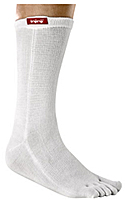
Performance Series Injinji sock.
First stop was at the Injinji booth. Injinji introduced "fingered" socks in a big way a few years back. At first, these were all anklets. I tried them and found that they reduced the amount of callous buildup between toes, and found other people who said they reduced blistering more than other sock schemes they had tried (hah! it's mostly boot fitting, folks, with socks the next level after you get the boots right).
Anyway, my complaint had been that there were no boot-height socks in their line. But my demands, er, suggestions, have been answered. So I picked up a pair of their merino wool crew socks and a pair of their Coolmax wicking socks for testing. Watch Trailspace reviews to find out if they work well. Yeah, I know, some people think "fingered socks" are weird. But for some uses, they may be the answer.
Hilleberg
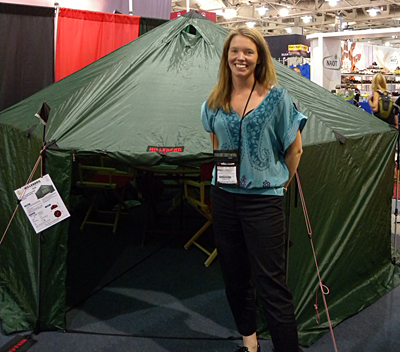
Petra Hilleberg and the Altai tent, Hilleberg's new six-person, yurt-shaped shelter.
Next to Hilleberg, since Bo Hilleberg had not been there earlier in the week. I took a photo of Petra Hilleberg standing next to the Altai tent, which I mentioned in my Day Two coverage. Petra's official title is President of Hilleberg USA, and she is based in Washington state.
I also got a good look at the Bivanorak, a combination bivy sack, anorak, and cagoule. It can be used as a bivy sack, for hiking with your full pack under it (tuck the bottom hem up and fasten in place with the drawstring), a rain jacket, and emergency shelter.
But mostly, I just chatted with Bo about skiing and snowshoeing in Sweden. He described the hut system in great detail, including the best times of year to go for summer and winter treks. The huts have a hut warden present during most of the year. The warden has food available, as well as stoves to cook on (lightens the pack). When the huts are crowded (such as in late March and in April), you can pitch your tent outside and still eat inside. I am keeping the best times of year as my personal secret (wouldn't want to get there and find half the Trailspace readers there at the same time!).
Leki
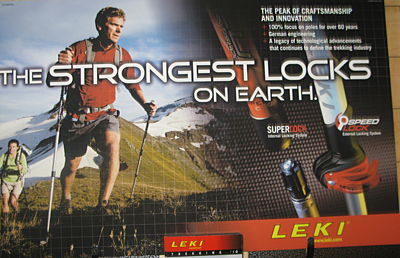
Display for Leki's new SuperLock mechanism.
Close to the Hilleberg booth was the Leki booth. At the Winter show, I had a discussion that has actually been continuing for a couple years about shock absorber vs non-shock poles. Most Trailspace readers know I do not like shock absorbers in my poles, although I strongly advocate using two poles for most hiking. The shock absorbers I have experienced tend to feel like pogo sticks. The Leki folks claim that their new shock absorbers are very different (I have a Leki monopod that has a shock absorber that I keep locked out).
This time they took the "try it you'll like it" approach. So I now have in hand a pair of their new Ultralite Thermolite Aergon poles, the Makalu. I will admit that in the brief test in the Salt Palace, they seemed to absorb the shock of a hard thrust reasonably without skittering like a shockless pole often does. We shall see after a few miles on the trails. I do promise to keep an open mind, and really am looking for things to help to aging muscles and joints.
Leki's new SpeedLock mechanism does not come with a shock absorber at present, so I am not testing that pole system out.
Adventure Medical Kits
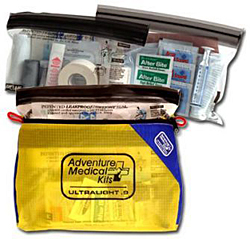
Ultralight Adventure Medical Kit
Adventure Medical Kits has done some repackaging of their line of first aid kits to more closely match the various types of outdoor activities. The Ultralight series is now double-packaged with an inner ziplock bag that remains sealed until you need it (transparent so you can see exactly what is in it), and carried inside a very light coated nylon outer bag. This keeps the supplies in condition longer.
The Pocket Survival packages are filled with items that have been found in practice to match what is really needed in survival situations. The other lines go all the way up to the equivalent of a full ER crash cart minus the prescription meds, and even then provide containers for them.
One thing I personally have found about the AMK kits is that they really do have what is needed (including a copy of Eric Weiss' little book that is filled with a wealth of "improvisational" information — you don't need a special splint device, since you already have what you need for a splint in your regular pack, IF you know how to recognize it, or look it up in the little book).
One of the recent additions to some of the kits and available separately is QuickClot, a powder that speeds the clotting of blood in a wound. This show they added a nosebleed version of QuickClot, which I suspect would come in handy for parents of young boys.
Lowrance
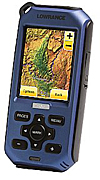
Lowrance Sierra
Lowrance continues to attempt to return to the consumer GPS receiver market with their Endura receiver line. These three units, the Sierra ($549.99), Safari ($384.99), and Out&Back ($229.99) differ primarily in the included basemaps, inclusion of barometric altimeter and magnetic compass, and those accessories apparently so vital these days, picture viewer, MP3, video player, and voice recorder (Magellan and Garmin also include these in certain models, with Delorme the lone holdout among the major handheld GPSR manufacturers in sticking to the navigation functions, leaving out the entertainment functions).
All three have color touchscreens, which is the standard these days. The high-end Sierra has the most detailed standard topographic maps, with a detailed road network and 100-foot contour intervals for the whole US.
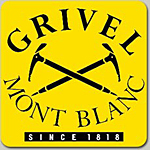 Grivel
Grivel
I visited the Grivel booth to find out what their current situation is, since Grivel North America (Mark Twight's company) had shut down last year. Grivel is now exporting directly from Italy to the U.S. So we will still be able to get the high quality Grivel climbing gear, possibly at a lower price, without the intermediate distribution center.
Bushnell
Out of curiosity (and because Alicia had asked about it) I stopped by the Bushnell booth to see what the story is with their BackTrack unit. This is a simplified GPS receiver that is intended to help the user return to their starting point without having to learn all the functions of the higher end GPS receivers. The retail price is about $70.
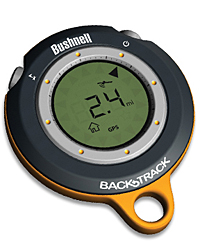 The unit is the size of a large (palm of the hand-sized) compass. At the start of your hike, you mark your location with one of three symbols. At two more locations along the way, you push a couple buttons to select another symbol, which provide a total of three reference points - your start and perhaps two trail forks. To return, a press of a button shows an arrow giving the direction to whichever of the three reference locations you want to return to. The arrow is connected to a built-in magnetic compass, so it will always point to your selected destination (straight-line direction). The unit does not show or record a track, so at trail junctions, you have to remember which branch of the fork you need to take.
The unit is the size of a large (palm of the hand-sized) compass. At the start of your hike, you mark your location with one of three symbols. At two more locations along the way, you push a couple buttons to select another symbol, which provide a total of three reference points - your start and perhaps two trail forks. To return, a press of a button shows an arrow giving the direction to whichever of the three reference locations you want to return to. The arrow is connected to a built-in magnetic compass, so it will always point to your selected destination (straight-line direction). The unit does not show or record a track, so at trail junctions, you have to remember which branch of the fork you need to take.
My initial feeling about this device is that it might be useful for a young child or an elderly person (that's someone at least 20 years older than I am!) who will not be going very far and will be on paths or trails with few branches. However, it is way too low a capability for general use. Consider that for under $100, and often for $50, you can find a more fully featured GPS receiver that a 4 or 5 year old can learn to use that shows tracks that the child can easily learn to follow, with a set of buttons that are only a bit more complex than the BackTrack. However, I have not actually used the BackTrack, and might find differently in use.
Petzl
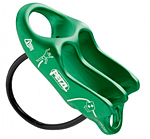 A couple of promised items in the climbing area are now available. One is the Petzl Reverso 3, a direct competitor to the Black Diamond ATC Guide. These belay/descender devices are very similar in having the deep notches to provide more friction for today's thinner ropes, plus a hole to attach a cord to aid in releasing the rope for an indirect belay. The major difference is that the release hole is vertical on the BD and horizontal on the Petzl. There is some discussion going on in the climbing community about which is better.
A couple of promised items in the climbing area are now available. One is the Petzl Reverso 3, a direct competitor to the Black Diamond ATC Guide. These belay/descender devices are very similar in having the deep notches to provide more friction for today's thinner ropes, plus a hole to attach a cord to aid in releasing the rope for an indirect belay. The major difference is that the release hole is vertical on the BD and horizontal on the Petzl. There is some discussion going on in the climbing community about which is better.
Omega Pacific
 Another item now available is the pair of smaller link-cams from Omega Pacific. The two larger sizes have been out for a while now and found a lot of enthusiastic users. While they are expensive, the wide range of cracks they fit reduces the number of cams that it is necessary to carry in the vital and common mid-sizes of cracks. In my experience with the two larger sizes, they seem more dependable than the various off-set and other approaches to extended-size cams. Still, the complexity of the construction gives a bit of pause, when compared to the simplicity of the more standard symmetrical cam designs.
Another item now available is the pair of smaller link-cams from Omega Pacific. The two larger sizes have been out for a while now and found a lot of enthusiastic users. While they are expensive, the wide range of cracks they fit reduces the number of cams that it is necessary to carry in the vital and common mid-sizes of cracks. In my experience with the two larger sizes, they seem more dependable than the various off-set and other approaches to extended-size cams. Still, the complexity of the construction gives a bit of pause, when compared to the simplicity of the more standard symmetrical cam designs.
Bluewater
Bluewater has introduced several haul lines that feature polyester sheaths. These should be more resistant to UV degradation, plus they are stiffer than their nylon counterparts. The extra stiffness partially counteracts the slipperyness of their tiny diameter when using them in a double-rope rappel, where the haul (or pull-down) line acts as the second line with the climbing rope.

 by Bill Straka
by Bill Straka









